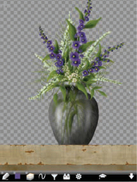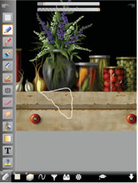Corliss Blakely
Soft Light/Luminous Tones + Still Life Composition Created in Multiple Layers

Pear
BY CORLISS BLAKELY
Artist
Vermont, USA
Established artist and seventh-generation Vermonter, Corliss paints still life and Vermont landscapes in a classically realistic style.
Corliss received her formal art training in Boston. While there she studied at Vesper George Art School and the Museum School of Fine Art.
Corliss Blakely has translated her expertise in oils to the iPhone, and using the app “Brushes”, teaches us the subtleties in creating her luminous still lifes.
I start with a dark background, then paint using a transparent wash in the foreground. The pear is just blocked in, so I wasn’t concerned about the shape or color. This approach to painting on an iPhone or an iPad is no different than one would use when painting in oils.

I start to paint the shape of the pear using transparent brush strokes.

As you see, the pear has taken on a different shape. Next, I build up the painting by using transparent color and large brushes. I can use the eraser to clean up the edges when adding an airbrush effect.
Time to play with more color. I love painting pears ... each one has such a personality. I keep layering in transparent color because it’s these subtle variations of color and light that give us the sense of realism. It is these subtleties that bring life to a “still life”. I add strokes of lighter and darker shades of color to define the light source. Now I can see the real shape begin to emerge.
Just using two layers to create this piece so far, I wanted to capture the reflection so I added another layer.

This is the blending stage. The skin of the pear has been softened and evened out. Now I begin adding the highlights and shadows.

Finishing the painting. This is when I concentrate on subtle lighting details, the soft light and the reflection of the pear. By using transparent soft brush strokes I have captured the essence of this pear, and its simple elegant beauty.



BY CORLISS BLAKELY
Artist
Vermont, USA
A master at traditional oils, a master at mobile art, Corliss Blakely demonstrates a still life captured on many layers.
Painted in “ArtStudio”.
Step 1
The first layer of the painting was the cupboard. By painting different shades on multiple layers with the preserve transparency option turned on, I was able to paint in the fine detail of the wood-grain. I went about this like an oil by glazing color and brush strokes to capture the patina of the grain.

Step 2
The knobs were done on a separate layer. I used the airbrush to achieve the shine.

Step 3
Zooming in allows me to paint the smallest detail, like the chips and cracks in the cupboard’s wood seen at right. Each brush can be custom-made so every stroke is exactly what you want.



Step 4
Once I finished the knob, I started painting the vase and flowers on separate layers with the vase on top. By using the airbrush eraser on the vase, I can reveal the background gradually to simulate looking through glass.


Step 5
I started painting in the jars with basic shapes and then used the spray paint to make them come to life.


Step 6
I finished the highlights on the jars and flower vase using the spray brush with low opacity and added a new layer for the lace. I drew in the outline and filled in the shape with a solid color. I then added a darker value for the shadow




Step 7
I softened the shadow with the spray brush, then I used the pencil eraser to cut out the design in the lace. Zooming in, I outlined the opening with a lighter color, to mimic the look of embroidery.

Step 8
I took out the black background to check and see if I had to make any changes. I softened the edges of the flowers to blend them in. One of the hardest thing for artists is to know when the painting is finished. I make all the layers visible, step back, take a careful look and say, “OK, that’s it,” sign it, done.




